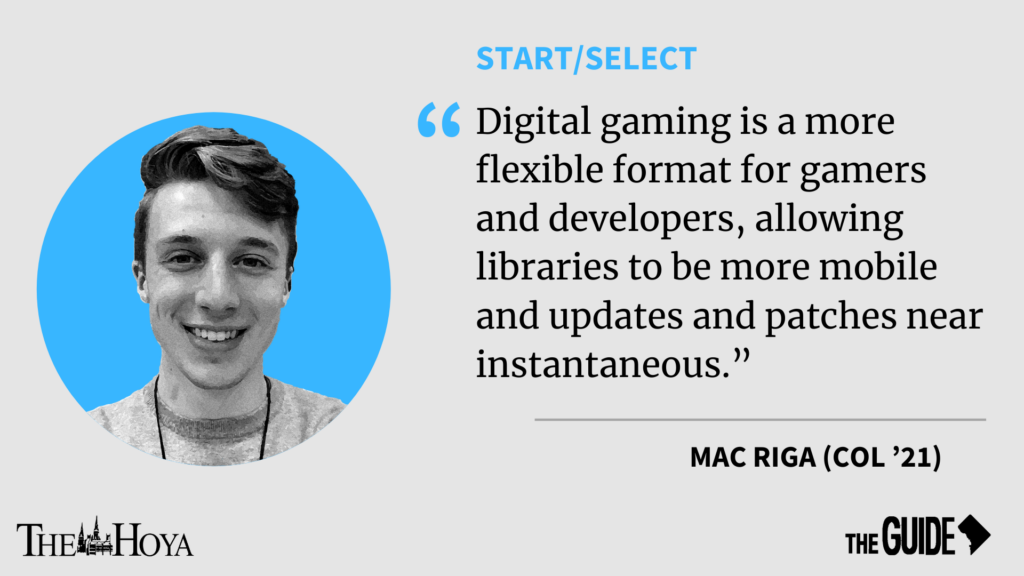Gaming distribution has been speeding up for years, and, thanks to some of the industry’s latest advancements in technology, it has proven to keep up despite the devastating impacts of the COVID-19 pandemic.
Sony, Microsoft and Nintendo all make use of manufacturing plants in China that, because of the pandemic, were promptly closed, halting production of consoles — something that has become apparent to anyone who tried to purchase a Nintendo Switch in the past few months. Game development teams, collaborative efforts consisting of hundreds, if not thousands, of people, were suddenly confined to their homes, and shortages and delays became the norm for the first time this year. The slowdown is particularly disappointing because the industry’s distribution model is poised to finish undergoing a rapid evolution that would have suited this situation perfectly, as millions are stuck at home looking for something to do indoors. Despite gaming’s extensive history with physical objects, a trend away from the physical has proven useful when it comes to adapting to today’s isolated environment.
Since its birth, gaming has lent itself to the presence of artifacts. In the 1970s, games were found only in massive arcade machines at specialized stores. With the rise of home gaming consoles later that decade, cartridges became the basic unit of gaming. This remained the norm for years. The sixth generation of gaming consoles saw the cartridges replaced with discs in the late 80s, but the change did not stick, since the Switch has recently re-adopted cartridges. The physical aspect of gaming would begin to change again in 2003 with the emergence of revolutionary PC gaming hallmark Steam.
Created by developer Valve to easily distribute update data to players, Steam quickly grew into the foremost digital retailer for PC games. For the first time ever, gamers could have entire libraries of games and not own a single piece of hardware, save their computer. Steam proved to be more convenient and accessible than traditional disc-based PC gaming. Games released on Steam were only a few keystrokes away; you never even had to leave the house. The games were cheaper, too, for players and developers alike. Without the need for packaging costs, disc production or licensing deals with distributors, developers could allow their games to hit the market at a lower price and go on sale with remarkable frequency.
Mitigated costs, combined with Steam’s lenient process for developers to get approval to sell their games through the service, gave smaller developers the forum for publication they had traditionally been barred from. Consoles, too, picked up on the model, and, by 2011, Xbox, Sony and Nintendo all had their own digital storefronts.
As digital gaming grew into the 21st century, so did cloud-based gaming. Cloud-based gaming allowed players to synchronize their digital libraries and game data with server banks miles away; if players purchased a new console or used a different computer, they would have access to all of their games and save data. This fascination with cloud gaming gave rise to the “game as service” model and the fledgling cloud-streaming service.
The “game as service” model saw games released initially and then supported with new content distributed digitally over the course of months or years, a technique that has drawn praise for increasing games’ longevity and criticism for being a cynical money grab and excuse to release unfinished products at full price. Cloud-streaming allowed players to access games digitally and play them immediately with no need for installation downloads and with far less beefy computer rigs than playing the same games via Steam or another service sometimes required, although it necessitated a constant internet connection to work reliably.
Digital gaming is a more flexible format for gamers and developers, allowing libraries to be more mobile and updates and patches near instantaneous. It has made gaming more affordable and accessible, with Steam becoming a bastion of cheap gaming and digital marketplaces providing smaller developers a place to learn and hone their craft without the fear of crippling overhead. In fact, Sony recently announced the PS5 will be available in a presumably cheaper version at launch that does away with its disk reader altogether for the first fully digital console Sony has released.
While many areas of the games industry came to a grinding halt with the outbreak of COVID-19, digital marketplaces and cloud-based streaming have been able to continue operating unimpeded and have even thrived. Digital gaming has also helped reduce the industry’s carbon footprint by doing away with wasteful plastic packaging. The future of gaming is undoubtedly a digital one.
I can’t remember the point when I started buying the majority of my games digitally, but, nowadays, only very special titles can convince me to order physically, and even those few deviances have clear downsides. Earlier this year, my car was burgled and my Switch, 3DS and all the games I had with them were stolen; the cost of replacing my physical library is too debilitating to undertake, even with an insurance payout, but 90% of my Switch library is safely stored in the cloud, ready for redownload whenever I so choose. The jump to digital has made the gaming world a more affordable, accessible and — if 2020 has forced it to be anything — a more flexible place.
Mac Riga is a senior in the College. START/SELECT will appear online every other week.
















Melvin Jacob • Dec 2, 2020 at 7:09 am
Thanks for such a great post. I found it really helpful as I am researching this topic currently. Would like to read more from your collection. Happy blogging.!